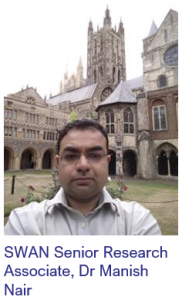In our spotlight blog series, we have been speaking to our Post-Doctoral Researchers, our aligned PhD students, and research team members from across the SWAN Prosperity Partnership to highlight their recent work within the project.
Next in our spotlight series, we asked one of our newer team members, SWAN Senior Research Associate Dr Manish Nair to tell us a bit more about what he has been up to since joining the project team in April 2020. Some of the highlights of Manish's work so far include developing machine learning (ML) techniques for RF fingerprinting and designing new waveforms for secure spectrum sharing.
What are your main research tasks within SWAN and how do these relate to your previous research experience?
 My main research tasks within SWAN span the intersection of all four of SWAN’s research challenges.
My main research tasks within SWAN span the intersection of all four of SWAN’s research challenges.
One key focus is conducting state-of-the-art research in frequency agile, blocker resilient and multi-band radio frequency (RF) receiver front-end analogue circuit technology, focussing on sub-6GHz applications embracing Secure by Design methodologies.
Another key research area involves applying novel machine learning (ML) methodologies to cyber-intrusion detection in low cost IoT systems (e.g. LoRa), as well as the latest telecommunication standards (e.g. 5G-NR). These ML methodologies include architecting advanced ML networks, inspired by computer vision, and algorithm development.
Novel waveform design, abiding by the principle of secure-by-design, is another one of our objectives.
We will also be investigating the design of full-duplex (FD) transceivers that allow for simultaneous transmit and receive capabilities in defence systems. Here, we propose active self-interference cancellation (SIC) receivers.
My previous research experience in power amplifier design, RFIC design, signal processing/resource allocation algorithms for mm-wave massive-MIMO/hybrid-beamforming systems/ML based resource allocation in NOMA, all of which aligns well with SWAN’s research tasks.
Can you give us a brief overview of the work you have been doing recently and how this relates to the SWAN Prosperity Partnership?
Under the guidance of Professor Mark Beach, we have:
- Investigated the insertion of artificial noise (AN) and coherent jamming for achieving resilience to jamming in the LTE physical downlink shared channel (PDSCH) through which OFDM frames are transmitted
- Demonstrated RF fingerprinting of LoRa modules. Take a look at our Overview and Demonstration of RF Fingerprinting video for more information.
- Proposed chirp-OFDM, a novel waveform exploiting chirp spread spectrum (CSS) modulation, which enables spectrum sharing at the resource element (RE) level. Such a waveform is also resilient to carrier-frequency-offset (CFO), symbol-time-offset (STO) and Doppler.
Where does this work fit in with SWAN’s wider Research Challenges?
This spans all the four research challenges (RCs) in SWAN, which are:
- RC1: Threat synthesis and assessment
- RC2: RF cyber detection and defence
- RC3: Cyber secure radio design
What will be the key outputs of this particular piece of work?
Through collaboration with researchers across the SWAN partnership, we will be disseminating our outputs in high impact factor IEEE conferences and IEEE transactions.
How have SWAN’s partners in industry and government been involved in this work package?
SWAN’s partners provide us with inputs as part of the research pedagogy, and we share our key results with them as well.
What are the next steps for this section of research?
Our first step will be to extend the RF fingerprinting of LoRa modules to incorporate LoRaWAN deployment. We will employ the channel emulator to understand how the SNR markers changes due to the channel environment. We plan to disseminate these in an IEEE Transactions in Microwave Theory & Techniques.
 Further, Dr Tommaso Cappello (Lecturer and SWAN researcher) has extracted signal statistics that we will apply to enhance or existing ML model for RF fingerprinting. These signal statistics bear the imprint of the PA which forms an RLC circuit with it’s low-pass characteristic filter response of its match. This would also form a part of our planned paper in IEEE Transactions Microwave Theory & Techniques.
Further, Dr Tommaso Cappello (Lecturer and SWAN researcher) has extracted signal statistics that we will apply to enhance or existing ML model for RF fingerprinting. These signal statistics bear the imprint of the PA which forms an RLC circuit with it’s low-pass characteristic filter response of its match. This would also form a part of our planned paper in IEEE Transactions Microwave Theory & Techniques.
We will also be investigating and developing the chirp-OFDM waveform further for secure spectrum sharing. Specifically, the number of spreading factors that can be ‘accommodated’ within a resource element, as well as the peak-to-average power ratio (PAPR) of such a waveform needs to be addressed. Once again, we will be disseminating this in a suitable IEEE transaction paper.
Finally, we will be investigating the design of full-duplex (FD) transceivers that provide for simultaneous transmit and receive capabilities in defence systems. Here, we propose active self-interference cancellation (SIC) receivers.
Can you tell us about any recent publications in the world of communication systems and networks research that have interested you?
There are quite a few in the world of communication systems and networks research that have inspired me over the years, but to highlight a few favourites:
[1] Laughlin, L., Zhang, C., Beach, M. A., Morris, K. A., Haine, J. L., Khan, M. K., & McCullagh, M. (2018). Tunable frequency-division duplex RF front end using electrical balance and active cancellation. IEEE Transactions on Microwave Theory and Techniques, 66(12), 5812-5824.
[2] Ginzberg, N., Regev, D., Keren, R., & Cohen, E. (2021). A 65 nm CMOS Quadrature Balanced Switched-Capacitor Power Amplifier for Full-and Half-Duplex Wireless Operation. IEEE Journal of Solid-State Circuits, 56(10), 3008-3020.
[3] O’Shea, T. J., Roy, T., & Clancy, T. C. (2018). Over-the-air deep learning based radio signal classification. IEEE Journal of Selected Topics in Signal Processing, 12(1), 168-179.
Is there anything else you would like to tell us?
I aspire to serve as a post-doctoral research associate and train as a research fellow and lecturer.
SWAN Prosperity Partnership
SWAN is an EPSRC Prosperity Partnership project dedicated to the creation of Secure Wireless Agile Networks (SWAN) that are resilient to both cyber attacks and accidental or induced failures. The partnership is made up of contributors from the Smart Internet Lab at the University of Bristol, Toshiba Research Europe Ltd, GCHQ, and Roke Manor Research Ltd.
Interested in reading more about SWAN and our programme of research? Take a look at our website for more information or sign up to our newsletter for regular updates on SWAN activities and opportunities to get involved.
